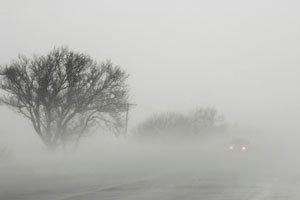Being There
by Mark Ellis
 The blue spruce across the street bent neatly in half, its tip touching the earth under a blizzard wind.
The blue spruce across the street bent neatly in half, its tip touching the earth under a blizzard wind.
I noticed the contortion a little after midnight on January 26, 1978, as I arrived home and tugged the front door closed behind me. My shift on the "night side" at the Columbus Dispatch ended in a scamper home in a gathering storm. The day before, an appetizer of winter thunder and lightning had only hinted at the weather that threatened around the corner, like a steak-fed brawler with brass knuckles.
The lightly staffed evening shift offered an advantage to a fledgling reporter hungry for stories. Opportunity was only a five-alarm fire away. But uneasy sleep under what would become the Blizzard of '78 inevitably gave way to a rattling morning and a tough choice. Stay home at the insistence of civil authorities, spouse, and good sense ... or claw my way into the office, because that's the best part of the news business—being there.
In this issue of the Bulletin, we offer a story about the famous blizzard and its impact on Kenyon. The story shook loose some memories that I'd kept in scrawled notebooks.
I made a break for the newsroom that afternoon. The paper needed the help, and I needed a byline. The flirtation with a bus ended quickly: the buses had shut down by that time. Businesses and government offices had emptied out. Stores were closed and gas stations locked down.
I eased the car into the heated garage below-decks at the Ohio Statehouse, directly across the street from the Dispatch newsroom. What was left of the day-shift team scattered for home or took shelter in a few rooms the newspaper had grabbed at the Neil House, the hotel on the opposite side of Capitol Square.
Adrenaline helped me across the street through the ferocious wind. To step outside was to sense not just a whipping snow that blinded the eyes but a respect for lethal force.
Naturally, the night city editor instructed me to stroll to the Greyhound station, about four blocks south, and interview stranded travelers. As I pushed through the newspaper's revolving door, which fought back, I was joined by a gritty photographer, a gentleman who always carried a weighted flashlight and a gun in his camera bag. If he had packed a rope in there, too, we would have tied ourselves together in the wind. We crept along the walls of buildings toward the station.
The hangar-style lobby was infused with the mingled scent of diesel fuel and chicken soup, a free dinner ladled up by volunteers. One surly traveler approached us to report that the broth needed more chicken. Duly noted.
That assignment was followed by visits to the Statehouse war room of Governor James A. Rhodes, who relished a crisis. Rhodes called on the Ohio National Guard to clear roads, deliver doctors to hospitals, and rescue the stranded. He slept that night in his office.
An improbable visitor showed up in the war room: Bob Evans, the Ohio farmer and restaurateur, wearing his customary cowboy hat, and bearing sustenance. Evans turned a fearsome night into, well, a fearsome night with sausage sandwiches.
As midnight passed, I looked forward with dread to the Friday night police beat, about eighteen hours away. But first I had to determine where to spend the night. One bed was left in one Neil House room. But that bed was in a room occupied by the newspaper's no-nonsense managing editor. So, yes, I risked the wrath of nature rather than the wrath of a former Air Force fighter pilot prodded from sleep by a kid writer with a moustache.
I headed for home, ignoring traffic lights and stop signs. Never has a Buick felt more fragile than when I navigated that white night.
And I was back on duty in less than twenty-four hours, working "night cops" as the storm's anger eased. Amply buffered by layers of clothes and boots, I braced for a shift that routinely demanded at least three stories about criminal mischief. But that night I was never called from the overheated reporters' office at Columbus police headquarters.
Crime, too, had frozen to a standstill, and for that a young reporter was grateful.
Veteran newsman Mark Ellis now hunts for scoops as the news director at Kenyon, where the "night cops" shift is a job for Campus Safety officers, not journalists.

 Delicious
Delicious Facebook
Facebook StumbleUpon
StumbleUpon Digg
Digg reddit
reddit